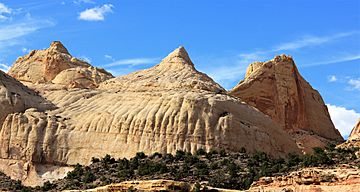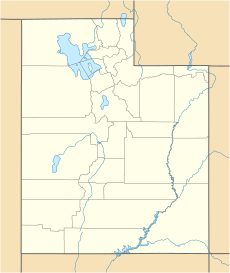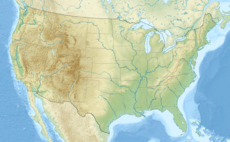Navajo Dome facts for kids
Quick facts for kids Navajo Dome |
|
|---|---|

Navajo Dome centered, southeast aspect
|
|
| Highest point | |
| Elevation | 6,489 ft (1,978 m) |
| Prominence | 489 ft (149 m) |
| Isolation | 0.38 mi (0.61 km) |
| Geography | |
| Location | Capitol Reef National Park Wayne County, Utah, US |
| Parent range | Colorado Plateau |
| Topo map | USGS Fruita |
| Geology | |
| Age of rock | Jurassic |
| Type of rock | Navajo Sandstone |
| Climbing | |
| Easiest route | climbing |
Navajo Dome is a tall rock formation in Capitol Reef National Park in Utah, United States. It stands 6,489 feet (about 1,978 meters) high. This amazing landmark is easy to spot! It's about 2 miles (3.2 km) east of the park's visitor center. It's also not far from another cool spot called Capitol Dome.
Rain and snowmelt from Navajo Dome flow into the Fremont River. This river eventually joins the mighty Colorado River. Navajo Dome rises about 1,100 feet (330 meters) above the Fremont River and Highway 24. You can see it clearly from the highway! To get close to its base, you can hike the Hickman Bridge Trail. The name "Navajo Dome" comes from the type of rock it's made of, called Navajo Sandstone, and its round, dome-like shape.
Navajo Dome is made of a type of rock called Navajo Sandstone. Scientists believe this sandstone formed around 180 million years ago. Back then, this area was a huge desert with giant sand dunes. It was the biggest sand sea in Earth's history!
In that hot, dry climate, strong winds blew sand around. This created large, wavy patterns in the sand, which are now visible as "crossbeds" in the rock. These patterns tell us about the wind direction from the Jurassic period.
Millions of years after these sandy layers were laid down, the entire Colorado Plateau slowly lifted up. This lift was mostly even, keeping the rock layers flat. However, Capitol Reef National Park is special because of the Waterpocket Fold. This is a huge, bent wrinkle in the Earth's crust. It formed between 50 and 70 million years ago during a time when mountains were forming, called the Laramide Orogeny.
Gallery
The best times to visit Navajo Dome are in spring and fall. The weather is usually mild and pleasant then. The area has a Cold semi-arid climate. This means that the coldest month has an average temperature below 32°F (0°C). Also, at least half of the yearly rain falls during spring and summer.
This desert climate doesn't get much rain, usually less than 10 inches (254 mm) per year. Snowfall in winter is generally light.
| Climate data for Capitol Reef Visitor Center, elevation 5,653 ft (1,723 m), 1981-2010 normals, extremes 1981-2019 | |||||||||||||
|---|---|---|---|---|---|---|---|---|---|---|---|---|---|
| Month | Jan | Feb | Mar | Apr | May | Jun | Jul | Aug | Sep | Oct | Nov | Dec | Year |
| Record high °F (°C) | 58.6 (14.8) |
68.3 (20.2) |
78.3 (25.7) |
84.4 (29.1) |
94.6 (34.8) |
100.2 (37.9) |
100.8 (38.2) |
97.9 (36.6) |
95.4 (35.2) |
86.1 (30.1) |
70.4 (21.3) |
61.5 (16.4) |
100.8 (38.2) |
| Mean daily maximum °F (°C) | 40.6 (4.8) |
46.4 (8.0) |
54.7 (12.6) |
65.0 (18.3) |
74.5 (23.6) |
85.3 (29.6) |
90.4 (32.4) |
87.9 (31.1) |
80.2 (26.8) |
66.1 (18.9) |
51.3 (10.7) |
40.6 (4.8) |
65.3 (18.5) |
| Mean daily minimum °F (°C) | 17.8 (−7.9) |
22.7 (−5.2) |
30.2 (−1.0) |
36.2 (2.3) |
44.7 (7.1) |
53.1 (11.7) |
60.4 (15.8) |
58.5 (14.7) |
50.4 (10.2) |
39.0 (3.9) |
27.6 (−2.4) |
18.2 (−7.7) |
38.3 (3.5) |
| Record low °F (°C) | −4.2 (−20.1) |
−11.8 (−24.3) |
9.1 (−12.7) |
18.1 (−7.7) |
27.2 (−2.7) |
34.6 (1.4) |
42.4 (5.8) |
45.1 (7.3) |
29.9 (−1.2) |
11.7 (−11.3) |
8.0 (−13.3) |
−7.5 (−21.9) |
−11.8 (−24.3) |
| Average precipitation inches (mm) | 0.52 (13) |
0.34 (8.6) |
0.53 (13) |
0.47 (12) |
0.59 (15) |
0.47 (12) |
0.91 (23) |
1.20 (30) |
0.80 (20) |
0.98 (25) |
0.49 (12) |
0.32 (8.1) |
7.62 (194) |
| Average dew point °F (°C) | 17.3 (−8.2) |
20.8 (−6.2) |
23.0 (−5.0) |
24.5 (−4.2) |
29.1 (−1.6) |
32.0 (0.0) |
40.0 (4.4) |
41.8 (5.4) |
34.8 (1.6) |
28.2 (−2.1) |
21.9 (−5.6) |
17.5 (−8.1) |
27.6 (−2.4) |
| Source: PRISM | |||||||||||||










